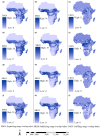Range dynamics of Anopheles mosquitoes in Africa suggest a significant increase in the malaria transmission risk
- PMID: 39091337
- PMCID: PMC11289791
- DOI: 10.1002/ece3.70059
Range dynamics of Anopheles mosquitoes in Africa suggest a significant increase in the malaria transmission risk
Abstract
Despite a more than 100-year effort to combat malaria, it remains one of the most malignant infectious diseases globally, especially in Africa. Malaria is transmitted by several Anopheles mosquitoes. However, until now few studies have investigated future range dynamics of major An. mosquitoes in Africa through a unified scheme. Through a unified scheme, we developed 21 species distribution models to predict the range dynamics of 21 major An. species in Africa under future scenarios and also examined their overall range dynamic patterns mainly through suitability overlap index and range overlap index. Although future range dynamics varied substantially among the 21 An. species, we predicted large future range expansions for all 21 An. species, and increases in suitability overlap index were detected in more than 90% of the African continent for all future scenarios. Additionally, we predicted high range overlap index in West Africa, East Africa, South Sudan, Angola, and the Democratic Republic of the Congo under future scenarios. Although the relative impacts of land use, topography and climate variables on the range dynamics depended on species and spatial scale, climate played the strongest roles in the range dynamics of most species. Africa might face an increasing risk of malaria transmissions in the future, and better strategies are required to address this problem. Mitigating climate change and human disturbance of natural ecosystems might be essential to reduce the proliferation of An. species and the risk of malaria transmissions in Africa in the future. Our strategies against their impacts should be species-specific.
Keywords: Africa; Anopheles species; future scenarios; malaria transmission; range dynamics.
© 2024 The Author(s). Ecology and Evolution published by John Wiley & Sons Ltd.
Conflict of interest statement
The authors declare that they have no known competing financial interests or personal relationships that could have appeared to influence the work reported in this paper.
Figures






Similar articles
-
Predicting and mapping malaria under climate change scenarios: the potential redistribution of malaria vectors in Africa.Malar J. 2010 Apr 23;9:111. doi: 10.1186/1475-2875-9-111. Malar J. 2010. PMID: 20416059 Free PMC article.
-
Malaria vectors in South America: current and future scenarios.Parasit Vectors. 2015 Aug 19;8:426. doi: 10.1186/s13071-015-1038-4. Parasit Vectors. 2015. PMID: 26283539 Free PMC article.
-
Ecological niche and potential distribution of Anopheles arabiensis in Africa in 2050.Malar J. 2014 Jun 3;13:213. doi: 10.1186/1475-2875-13-213. Malar J. 2014. PMID: 24888886 Free PMC article.
-
Distribution and insecticide resistance profile of the major malaria vector Anopheles funestus group across the African continent.Med Vet Entomol. 2024 Jun;38(2):119-137. doi: 10.1111/mve.12706. Epub 2024 Feb 2. Med Vet Entomol. 2024. PMID: 38303659 Review.
-
Climate, environment and transmission of malaria.Infez Med. 2016 Jun 1;24(2):93-104. Infez Med. 2016. PMID: 27367318 Review.
Cited by
-
Niche Shifts Induce Major Changes in the Ranges of the World's Worst Invasive Ant Species.Ecol Evol. 2025 Jul 8;15(7):e71754. doi: 10.1002/ece3.71754. eCollection 2025 Jul. Ecol Evol. 2025. PMID: 40635794 Free PMC article.
-
Future Range Shifts in Major Maize Insect Pests Suggest Their Increasing Impacts on Global Maize Production.Insects. 2025 May 28;16(6):568. doi: 10.3390/insects16060568. Insects. 2025. PMID: 40558999 Free PMC article.
References
-
- Adeogun, A. , Babalola, A. S. , Okoko, O. O. , Oyeniyi, T. , Omotayo, A. , & Izekor, R. T. (2023). Spatial distribution and ecological niche modeling of geographical spread of Anopheles gambiae complex in Nigeria using real time data. Scientific Reports, 13, 13679. 10.1038/s41598-023-40929-5 - DOI - PMC - PubMed
-
- Ageep, T. B. , Cox, J. , Hassan, M. O. M. , Knols, B. G. , Benedict, M. Q. , & Malcolm, C. A. (2009). Spatial and temporal distribution of the malaria mosquito Anopheles arabiensis in northern Sudan: Influence of environmental factors and implications for vector control. Malaria Journal, 8, 1–14. 10.1186/1475-2875-8-123 - DOI - PMC - PubMed
-
- Agyekum, T. P. , Botwe, P. K. , Arko‐Mensah, J. , Issah, I. , Acquah, A. A. , & Hogarh, J. N. (2021). A systematic review of the effects of temperature on Anopheles mosquito development and survival: Implications for malaria control in a future warmer climate. International Journal of Environmental Research and Public Health, 18, 7255. 10.3390/ijerph18147255 - DOI - PMC - PubMed
-
- Akogbéto, M. C. , Salako, A. S. , Dagnon, F. , Aïkpon, R. , Kouletio, M. , & Sovi, A. (2018). Blood feeding behaviour comparison and contribution of Anopheles coluzzii and Anopheles gambiae, two sibling species living in sympatry, to malaria transmission in Alibori and Donga region, northern Benin, West Africa. Malaria Journal, 17, 307. 10.1186/s12936-018-2452-9 - DOI - PMC - PubMed
LinkOut - more resources
Full Text Sources

